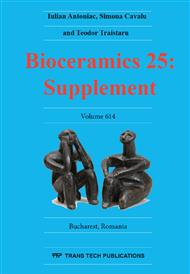[1]
L.L. Hench, R.J. Splinter, W.C. Allen, T.K. Greenlee. Bonding mechanisms at the interface of ceramic prosthetic materials. J Biomed Mater Res Symp 2 (1971) 117–41.
DOI: 10.1002/jbm.820050611
Google Scholar
[2]
R. LeGeros Properties of osteoconductive biomaterials: calcium phosphates. Clin Orthop Relat Res 395 (2002) 81–98.
DOI: 10.1097/00003086-200202000-00009
Google Scholar
[3]
M. Bohner, U. Gbureck, J.E. Barralet, Technological issues for the development of more efficient calcium phosphate bone cements: a critical assessment, Biomaterials 26 (2005) 6423–9.
DOI: 10.1016/j.biomaterials.2005.03.049
Google Scholar
[4]
A.S. Hoffman, Hydrogels for biomedical applications, Adv. Drug Del. Rev. 43 (2002) 3–12.
Google Scholar
[5]
N.A. Peppas, J.Z. Hilt, A. Khademhosseini, R. Langer, Hydrogels in biology and medicine: from molecular principles to bionanotechnology, Adv. Mater. 18 (2006) 1345–60.
DOI: 10.1002/adma.200501612
Google Scholar
[6]
J.F. Mano, G.A. Silva, H.S. Azevedo, P.B. Malafaya, R.A. Sousa, S.S. Silva, Natural origin biodegradable systems on tissue engineering and regenerative medicine: present status and some moving trends, J. R. Soc. Interface 4 (2007) 999–1030.
DOI: 10.1098/rsif.2007.0220
Google Scholar
[7]
L.L. Hench, I.D. Xynos, J.M. Polak, Bioactive glasses for in situ tissue regeneration, J. Biomater. Sci. Polym. Ed. 15 (2004) 543-62.
DOI: 10.1163/156856204323005352
Google Scholar
[8]
J.W. Reid, A. Pietak, M. Sayer, D. Dunfield, T.J.N. Smith, Phase formation and evolution in the silicon substituted tricalcium phosphate/apatite system, Biomaterials 26 (2005) 2887–2897.
DOI: 10.1016/j.biomaterials.2004.09.005
Google Scholar
[9]
M. Sohrabi, S. Hesaraki, A. Kazemzadeh, M. Alizadeh, Development of injectable biocomposites from hyaluronic acid and bioactive glass nano-particles obtained from different sol-gel routes, Mater. Sci. Eng. C 33 (2013) 3730-44.
DOI: 10.1016/j.msec.2013.05.005
Google Scholar
[10]
H.L. Alves, L.A. D. Santos, C.P. Bergmann, Injectability evaluation of tricalcium phosphate bone cement, J. Mater. Sci. Mater. Med. 19 (2008) 2241-6.
DOI: 10.1007/s10856-007-3329-6
Google Scholar
[11]
W.T. Yian, A. Preston, N. Schiller. Alginate lyase: review of major sources and enzyme characteristics, structure-function analysis, biological roles, and applications. Annual Rev. Microbi. 54 (2000) 289-340.
DOI: 10.1146/annurev.micro.54.1.289
Google Scholar
[12]
C.C. Ribeiro, C.C. Barrias, M.A. Barbosa, Calcium phosphate-alginate microspheres as enzyme delivery matrices, Biomaterials, 25 (2004) 4363-4373.
DOI: 10.1016/j.biomaterials.2003.11.028
Google Scholar
[13]
J. Necas, L. Bartosikova, P. Brauner, J. Kolar, Hyaluronic acid (hyaluronan): a Review. Veterinarni Medicina 53(2008) 397-411.
DOI: 10.17221/1930-vetmed
Google Scholar
[14]
L.D. Kai D., Zhu X., Zhang L., Fan H, Zhang X, Addition of sodium hyaluronate and the effect on performance of the injectable calcium phosphate cement, Mater. Sci. Mater. Med. 20 (2009)1595-1602.
DOI: 10.1007/s10856-009-3728-y
Google Scholar


